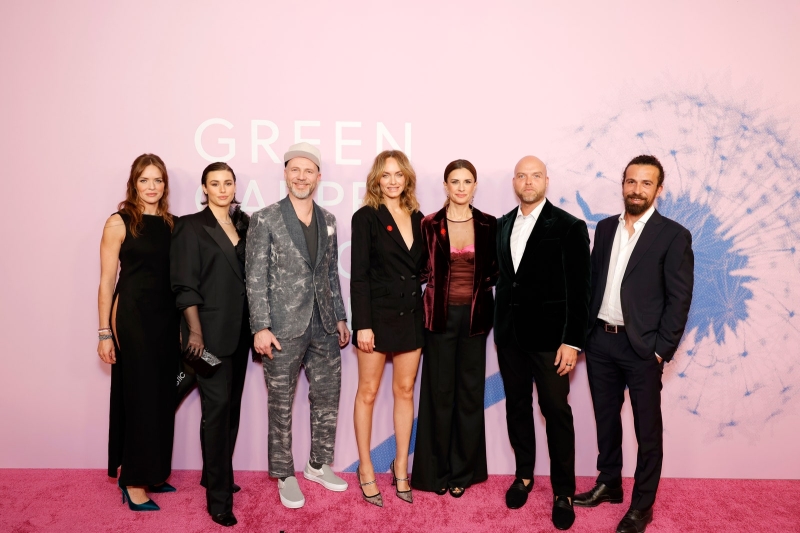
Do you ever wonder what sartorial final resting place a red carpet look ends up in? In the closet of the celeb who wore it, perhaps, or maybe straight into the safe haven of the designer’s archive. Then again, it could languish on a sample rack before it ends up in a sale months—or years—later. (It’s not the racks that got smaller, it’s the awards shows.) On the other hand, the look that model and activist Amber Valletta wore to the Green Carpet Fashion Awards last night in Los Angeles—an event hosted by Livia Firth, the Green Carpet founder, along with Zendaya, Cate Blanchett, Helen Hunt, Julianne Moore, Annie Lennox, Brazil’s Minister of Indigenous People Sônia Guajajara, and Ugandan climate justice activist Vanessa Nakate—could have a whole other future.
Valletta’s short Triarchy black tuxedo dress (few rock a tux better than her, as anyone who has ever seen her in YSL will attest) was made from denim by an Italian company called Candiani Denim. The fabric, by virtue of its specially developed stretch agent, called COREVA, can be cut into a million tiny pieces… and then used as fertilizer because it is compostable—the world's first, in fact. No, really. It’s not so much eat your greens as eat your jeans.
“Technically, yes—my dress could be shredded and used to grow tomatoes,” said Valletta over the phone from LA a couple days before the awards ceremony, adding, with a laugh, “I’m just hoping that I have time to get home and back into my sweats before it gets shredded and used.” That tomato-growing line, though, is no joke. In fact, the narrative is quite straightforward. “Of course, we need to understand the science and data and hard facts,” says Valletta, “but this story is also just so easy, and so charming: Who doesn’t love tomato pasta sauce, and who doesn’t love jeans?”
What happened was this: Alberto Candiani has long been developing more sustainable ways to manufacture denim, and after five years of work found a way to make it—with some degree of stretch—so that the denim can be biodegradable and thus become part of a cycle of circular agriculture. (Most stretch fibers are made of petroleum—clearly not a good thing.) For Candiani, this was a huge step forward. “Denim is cotton—the very first step of its making process is a seed in the soil,” he said. “The future is about connecting fashion with the agricultural industry.”

Enter Firth and her brother Alessandro Giuggioli, who co-own the regenerative farm Quintosapore in Perugia, Italy. Giuggioli decided to see what would happen when the Candiani denim biodegraded in the earth—what impact it had on their plants—and discovered that not only was their crop better than before, but (farmers’ market veggie producers the world over, take note!) “the soil was softer, and the denim increased water retention; we didn’t have to use as much water to look after the tomato plants.” When he tested the soil, its chemical composition was unchanged—both soil and produce were healthy. The big picture, as he noted: “If we create products using natural fibers and then return those natural fibers to the soil at the end of their lifecycle and align farmers to more regenerative techniques, we can solve some of the huge issues of both the fashion and the farming industries.”
As for Firth, she’s delighted that this whole process has provoked discussion and debate—and, it’s to be hoped, effected meaningful change, which has become the clarion call of both the Green Carpet Fashion Awards and her Eco-Age consultancy. “It’s like, How do we solve the problem?” she asked. “Is there a way in which technology is applied to the natural world in a way that can be more organic and soft? That is where these two Italian guys, who are basically nerds”—Firth said it with love—“come in. One is a nerd of denim, and the other other is a nerd of farming. We started talking, and we basically threw down a challenge: Can you actually grow tomatoes in the soil where you plant denim scrap? We tried it, and it worked. No one knows what’s going to happen now—will we be able to wear clothes that, ultimately, we can eat?” (For all the absolute seriousness with which she tackles things, Firth also finds time for brevity. What did she serve for dinner at the awards yesterday? Yep, pasta pomodoro. See her recipe for the perfect tomato sauce below.)
Whether or not Adam Taubenfligel, the creative director of Triarchy, was thinking about whether his designs could be eaten, he wanted to use the Candiani denim simply because it challenged the use of harmful stretch denim. “To date, every pair of stretch jeans that has ever existed has been made from crude oil-based plastics,” he said via email. “This means they will shed microplastics throughout their life, and then take over 200 years to degrade—with toxic offsets—at their end of life. People have come to expect stretch in their jeans, yet this convenience has carried a significant environmental cost: In reality, they more closely resemble a plastic bag than the timeless fabric of traditional denim. Our plastic-free stretch means that the material will biodegrade in less than two years at its end of life, contributing to soil health as it decomposes. Pairing this technology with regenerative cotton makes it the most responsibly made stretch denim to date—it has the ability to change the denim industry.”
When Valletta decided to wear her Triarchy look to the Green Carpet Fashion Awards, she was thinking about impact in the most positive of ways. “I’m hoping that people will be interested in this initiative, which pushes forward,” she said. “But this isn’t just a dream of the future—the innovations are here.” And yet, as Valletta pointed out, this development plays but one part in the necessary sea change that still needs to happen. “The other hope is that people see it, think it is desirable, and decide to invest in something that’s actually not bad for the environment,” she continued. “It’s recyclable and completely biodegradable—but that would be only after wearing it for a long, long time. We still don’t want to buy something to wear just once and then shred it.”
Livia Firth’s tomato sauce:
“This tomato pasta sauce has only 4 ingredients, so the trick is to choose high-quality ones,” says Firth.
Tomato purée (around 150 gr. or 3/4 cup per portion)
Extra virgin olive oil
1 clove of garlic
A bunch of fresh basil
Cook your pasta separately, bringing a pot of water to a boil and adding your pasta of choice. Crush the garlic clove and add it to a pan with a generous amount of olive oil (2/3 tbsp per serving). Heat the garlic and oil for 2 to 3 minutes, then add the tomato purée to the the pan and stir. Add a fresh sprig of basil for every 2 servings, then add half a glass of water and cook for at least 30 minutes. (The sauce has to be reduced by 1/3, and you want it to end up thick and creamy.) Once the sauce has finished cooking, salt to taste and remove the basil sprigs and the garlic. Drain the pasta al dente, add it to your sauce in the pan, stir, and cook for another minute. Serve with some basil leaves and a drizzle of olive oil. Once on the table, each guest can add parmesan to their liking.

